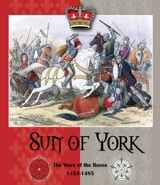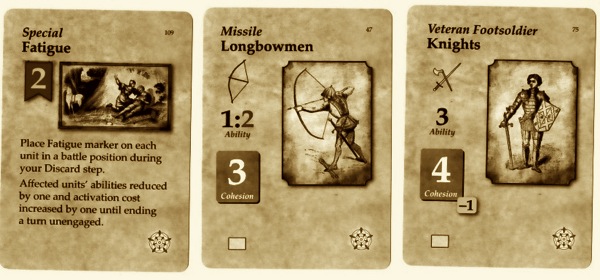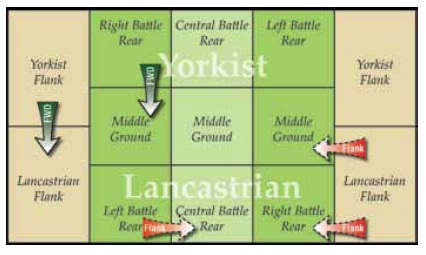Sun of York – Card Game Review
 Sun of York: The Wars of the Roses, 1453–1485. Card game. GMT Games. Design and development: Mike Nagel. $55.00
Sun of York: The Wars of the Roses, 1453–1485. Card game. GMT Games. Design and development: Mike Nagel. $55.00
Passed Inspection: Turns move quickly; quality components; great replay value.
Failed Basic: Obtusely written rules obscure how simple this game is to play; too many Longbowmen cards.
Let’s deal with the biggest negative up front: Verily, the way the rules are written doth cause a winter of discontent. This is a very simple game to play, but I found myself repeatedly re-reading some rules sections to grasp what the designer was trying to say. Comments I’ve read on forums indicate my experience was not unique. Once I got past the problem areas, however, I found Sun of York is fast moving and fun. It comes with a bushel of scenarios, none of which will play the same way twice. A two-player game, it is also easily played solitaire.
{default}In Sun of York, the Lancastrian and Yorkist players each have their own deck of cards. Cards are played in a pattern of three columns and three rows. The rules use the medieval term "battle" for each column, and I think this is part of the problem: most people today, including most wargamers, think of a battle as active combat between two enemies. In Sun of York, it can refer to playing areas where no fighting is presently going on. For this review, I’ll refer to columns and rows. The spot where a row intersects a column, I’ll call a box. There are also flanks, but more on those later.
Cards in Sun of York
Terrain: All Terrain cards called for in a scenario are placed on the table at the beginning of the game; no additional Terrain can be added later. Any additional Terrain cards you draw can be played as a source of Order Points (OPs), which are necessary for moving troops. The OP value of Terrain—or any other type of card that can provide OPs—is shown as a number in a red pennant at the upper left of the card. The Terrain type is irrelevant when the card is played for its OPs; only the OP number counts.

Leader: Combat units cannot move unless accompanied by a Leader card or through the expenditure of OPs. Leaders that are in play can attack opposing leaders, using their Ability rating (the number below the red pennant). Below the Ability number is the Leadership rating, which can give Combat Units positive modifiers if the Leader has been committed to fight along with those units. Each scenario states which leaders may be put into play; in most cases those are placed on the table before the game begins. All other Leaders drawn are useful only for their OP value, which is used only once; that Leader card is then discarded. Leaders that are in play for the scenario do not use their OPs and remain in the playing area until events, such as death, dictate otherwise.
Combat Unit: These range from Knights to Levies. Each has two numbers (missile-firing units have 3). The top number is the unit’s Ability rating; roll that number or less on a six-sided die to put a hit on an enemy unit. Missile units have two Ability numbers separated by a colon. The red number is for ranged attacks, the black one is used when the unit is engaged. Below the Ability number(s) is the unit’s Cohesion rating. Cohesion tells you the number of dice to roll for that unit in combat and serves as the unit’s morale rating. A few units have a small –1 inside a box beside the Cohesion rating. These are veteran units; subtract one from the die roll when making their morale check.

Special: Ten Special cards "are provided to add historical flavor." For example, Charge allows a unit to move and attack in the same turn. Margaret of Anjou (only the Lancastrian has this card) provides three OP per turn to reactivate units so they can have a second round of movement or combat.
Along the bottom of Combat Unit and Leader cards are one or two blank rectangles, indicating how many boxes the unit may move in a turn. There is also a white or a red rose, denoting the card’s faction, Yorkist or Lancastrian.
Apart from the two decks of 110 cards each, SoY comes with five high-quality dice, 140 status markers, and two player aid cards. The rulebook includes an extensive example of play and 20 scenarios, plus instructions for creating random scenarios and for conducting a campaign game.
The Playing Area
As noted above, the primary playing area consists of three columns and three rows.
- Columns: For the most part, Combat Units played into one of the three columns must stay in that column. Leaders can move from one column to another.
- Rows: The row closest to the Lancastrian player is the Lancastrian rear area; vice-versa for the Yorkist. Each player plays Combat Units from his hand into his rear area as the game progresses. The middle row is the middle ground, where most combat occurs.
Victory is instantaneous when one player either captures the box where the opposing player’s middle column and rear-area row intersect or by capturing the two boxes on either side of it.

The playing area in Sun of York, as illustrated in GMT’s rulebook.
Going to Battle in the Wars of the Roses
After players choose a scenario and place the designated weather marker, they pull from their decks any Leader, Terrain, and Special cards the scenario calls for and place them as directed. One player may have to then reshuffle and discard a number of cards, to reflect the other side’s numerical superiority. Each player deals himself 16 cards and selects 12 to deploy immediately or discard, leaving four cards as his initial hand. Two useful options are provided for creating less random initial deployments.
Turn Sequence: One side performs all of its actions, then the other side does the same, which completes one turn.
Determine Initiative through die rolls. Unfortunately, this important step was left off the player aid cards. Play moves so quickly that I’ve found it is easy to forget whether you are about to start the second player’s phase or a new turn, especially when playing solitaire, so I adopted the practice of putting a coin underneath the initiative marker while the first player performs actions and removing the coin at the beginning of the other player’s phase—a British coin, of course.
Morale: The phasing player checks each Combat Unit that suffered hits last turn, rolling one die for each hit. If the modified result of any of the dice is greater than the unit’s current Cohesion status, that unit retreats one box, but all the hit markers on it are removed. If the modified die roll is less than or equal to the current Cohesion status, the unit stands and absorbs its hits. Remove its hit marker(s) and lower the unit’s Cohesion by the number of hits sustained. Note that if a unit takes hits while in its rear area, it has no place to retreat to; if it fails its morale check, the unit is discarded.
Also roll one or more dice for Leaders that were committed to combat and/or took hits the previous turn. A six on any of the dice results in a kill (or a wound in campaign games).
Combat: Non-missile units must begin the Combat phase in a box with enemy units in order to engage them. Missile units (longbow, crossbow, handgunners) may fire from one box away, providing there are no enemy units in their box and no friendly units are in the box they are firing into.
Combat is simple: Roll a number of dice equal to a unit’s current Cohesion level; every modified die result less than or equal to the unit’s Ability rating puts a hit on an opposing unit, which will cause a morale check during the opponent’s Morale phase. Hits must be distributed equally among the units in given box.
Movement: Placing Movement after Combat is a key element to this game’s design: You can’t immediately reinforce a battle or advance after combat. Combat Units must be accompanied by a Leader, or the player must expend OPs by playing cards from his hand—if he has them. Those cards are then discarded. An OP must also be expended when playing a Combat Unit from your hand into a rear area. Only four Combat Units can "stack" in a box.
Most movement is up and down the columns, but there are four areas on each side of the playing area known as the Flanks. I found flank attacks to be the most confusing part of the rulebook, but basically, it works like this:
Expend two OPs for each unit you play from your hand to one of your two friendly flank areas. Movement to the opponent’s adjacent Flank cost area costs two more OPs per unit. You cannot move farther than your units in the adjacent non-flanking column have advanced, i.e., if those units are still fighting for the Middle Ground, you can’t move into your opponent’s Flank area.
To attack from a Flank area, you must expend an OP for each attacking unit and roll a die for each unit. On a three or less, those units can join non-flanking units in whuppin’ up on the enemy in an adjacent box. On a six, the unit is removed from play. A four or five, it simply fails to attack—but the OPs spent are gone.
At the end of movement, discard any unwanted cards and draw to bring your hand back up to four.

In this view of combat in the middle ground at the end of the Lancastrian (top) Combat Phase, the Yorkist pikemen on the left have taken two hits, the knights have taken one. The Yorkist player, in his Morale Phase, will have to roll 1d6 for the knights, 2d6 for the pikemen. A result greater than the unit’s current Cohesion will force that unit to retreat—but the hits will then be removed without effect. If the result is equal to or less than current Cohesion, the unit stands and its Cohesion drops by one. That would be very bad for the knights, whose Cohesion is already down to one; they would be eliminated. Both units are veterans, denoted by the –1 beside their Cohesion rating.
So Is It Sunny in York?
Reading the description of play is more difficult than actually playing the game, and Sun of York is fun to play, with battlefield fortunes changing rapidly. It works well as a solitaire game, and I suggest playing a scenario or two solitaire to establish familiarity before inviting a friend over. Each turn plays through quickly, but the back-and-forth nature of the battles means some games will take a couple of hours, though most last 30–90 minutes.
On the down side, apart from some obtuse wording in the rules, there are ‘way too many Longbowmen, who are great at range, but since they can’t fire into melees they lose that advantage quickly. Each side’s Combat Units consist of 15 Levies, 10 Men-at-Arms, 3 Pikemen, 5 Billmen, 3 spear-armed Cavalry, 3 Knights, 4 Crossbowmen, and 1 Handgunner. The Lancastrians also have 30 Longbowmen; the Yorkists have 33. The number seems high considering the length of time required to create longbows and train archers.
Also, keeping the Cohesion and Hit markers on the correct cards can be problematic, especially in larger melees.
Despite those flaws and a couple of annoying typos in the scenarios, I cheerfully recommend Sun of York for its fun factor, large number of scenarios, high replay value, and solitaire compatibility.
Armchair General rating: 87%
Solitaire Suitability: 4 out of 5
About the Author
Gerald D. Swick is senior online editor for Armchair General. He bought his first wargame during the centennial of the Civil War (American, not British), and today he has entirely too many boardgames, RPGs, and historical miniatures and too little time to play with them.


0 Comments
Trackbacks/Pingbacks